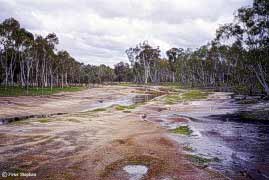|
|
|
Timber plantations for salinity control

Revegetation of recharge areas is widely acknowledged
as being a possible means of controlling the rising watertables
that contribute to dryland salinity. Hydrological surveys
often identify the principal recharge areas as the cleared
well-drained hillslopes where water easily penetrates. To
control the recharge farmers are often advised to establish
a canopy of evergreen perennial vegetation that can dry the
soils to a suitable depth or intercept subsoil drainage. The
trees or shrubs do not necessarily need to be indigenous,
or even native, but they must be able to grow well on the
site and survive droughts and/or other threats. The costs
associated with revegetation and the subsequent loss of agricultural
production from the planted area represent a real and substantial
investment, whereas the environmental return is often uncertain,
not immediate and difficult to describe in dollar terms.
Depending on a farmer's other interests, he/she might consider
establishing a commercial plantation on the recharge site.
If an industrial forestry company is offering a commercial
joint venture or lease, they may be able to negotiate for
a plantation to be established on the site. To be effective
in controlling salinity, the plantation must be located correctly,
remain productive and be harvested in a way that doesn't allow
recharge to return to the pre-planting levels. This may mean
that conventional plantation species or management methods
are inappropriate. For instance, Blue Gum (E. globulus) is
susceptible to drought deaths on dry, well-drained sites so
alternative, although less vigorous, species such as Sugar
Gum (E. cladocalyx) may be more suitable. If such areas are
also difficult to access and expensive to harvest, growing
low value products like pulpwood would be unviable, whereas
sawlogs may be viable to harvest due to higher log values.
Although the site may not be ideal for high value timber production,
a farmer may be willing to accept a lower return, in order
to achieve salinity control. This may mean lower lease payments
or lower prospects of deriving a profit from the timber. Where
the costs of establishing a non-commercial forest are prohibitive,
the multipurpose option reduces a farmer's exposure to risk
while meeting their most critical environmental concerns.
The fact that the plantation is not viable to establish on
the basis of timber production alone is not critical. What
is important for timber production is that the trees are viable
to harvest at some time in the future.
Waterlogging
and salinity
Planting trees
to reduce waterlogging and salinity
Back to top
|
